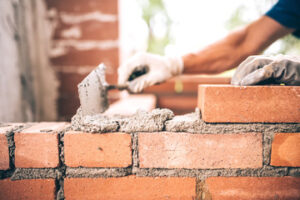What Is Masonry?
Masonry Charleston SC is the process of building structures out of individual units, usually laid in mortar. It is an extremely important process in construction, as it will ensure a building’s structural integrity. The process is used for many purposes, including the construction of roads, bridges, and buildings. It is also a great way to save money on construction projects.

Masonry is often used in the construction of buildings, such as houses and offices. It can be very cost-effective when compared to framed construction. Masonry walls also hold up well to heavy loads. Often built with hollow units, they also prevent water damage. When built properly, masonry walls can completely enclose the interior from the exterior.
When laying masonry walls, it is vital that corner poles are level and properly aligned. In addition, the first course of masonry is laid in mortar, with a 1/4 to 3/4-inch mortar joint. This joint is necessary to compensate for the irregularities in the footing. A full bed joint is also recommended for the initial course.
Masonry requires skilled masons. It includes brick, stone, and concrete masonry, among other things. Oftentimes, the training involves an apprenticeship. An apprentice will get on-the-job training from a professional mason while also taking formal classroom-based classes. A typical apprenticeship lasts about four years and prepares the trainee for a career in masonry. In addition to on-the-job training, apprentices may specialize in a particular skill set.
Bricks come in a variety of colors, shapes, and textures. Historically, they were formed from rock and stone. Cement mortars were used to join the units together. Portland cement plaster is also used in the construction of masonry buildings. In recent years, modern bricks can be artificially aged through surface treatments.
While bricks are cheap and easy to handle, they do not last as long as stone or concrete blocks. This means that a brick structure can deteriorate over time and may require replacement. Bricks also require plasterwork, which can be expensive. As a result, brickwork isn’t ideal for structures with high foot traffic.
Another benefit of masonry is its fire resistance. Masonry walls also act as a sound barrier. This helps insurance providers pay their claims after natural disasters. As a result, masonry buildings are popular in places near airports and freeways. They keep noise out of the building, thus helping the residents avoid noise pollution.
In addition to using concrete and brick, masonry walls can be reinforced with steel rods. Reinforced masonry walls can withstand higher pressures, such as those experienced in earthquakes. They are also more likely to resist cracking. In addition to being more resistant, reinforced masonry walls can withstand heavier compression loads.
Brick and cinder blocks are the most common masonry materials used in construction. They provide a durable and attractive appearance and can be used as weight-bearing members. Bricks are also very versatile and can be found in many different colors and styles. Many bricks have even been designed to mimic the look and feel of more expensive materials. They can be used in virtually any building. You can even get them custom-made to meet the exact specifications of your project.
Many architects and designers value masonry for its ability to control noise, resist fire, and insulate against daily temperature fluctuations. For these reasons, masonry was often used in 20th-century housing over wood-stud construction. Cavity walls were commonly constructed with two layers of masonry, and some foundations were made of concrete blocks. Many building codes even required the use of masonry in firewalls. You can also choose a variety of wall configurations for masonry construction.
As masonry is a labor-intensive process, it can be costly. However, it’s worth it in the long run. When done well, masonry can increase the resale value of a home. Although masonry is a very durable option, it is still a more expensive option than other construction materials.
